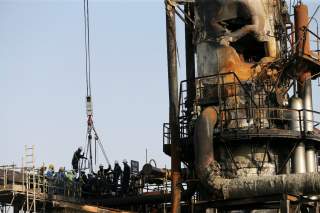by Stratfor Worldview
Iranian protestations of innocence notwithstanding, the arrows following last week's massive drone and missile strikes on oil infrastructure in Saudi Arabia all point toward Tehran. In this, there's one key question that's on everybody's mind: What is Iran after? While Tehran's aggression has made the probability of a U.S. or Saudi military strike on Iran higher in the short term, the Islamic republic does not necessarily intend to trigger such a strike and the ramifications it would entail. On the contrary, Iran is hoping to force an end to the United States' maximum pressure campaign sooner, rather than later — even if that requires riling up the world's superpower even further.
Getting on the Front Foot
Ever since the United States withdrew from the Joint Comprehensive Plan of Action, or the Iranian nuclear deal, in May 2018, Iran's hard-liners have emphasized that the country must maintain credible deterrence. This means that Iran's escalation has served two interests: Make the United States and its allies pay a higher cost for its pressure campaign and establish the credibility of Iran's threats. Iran has clearly accepted the risk that such an escalation could result in a conflict with the United States, but its demonstration of a credible regional threat and a willingness to use it is forcing the United States to think twice about conducting a strike on Iran.
Ultimately, Iran is striking while the iron is hot because the status quo is simply unsustainable. The country's economy is dependent on oil exports, which have collapsed under the weight of U.S. sanctions. As a result, inflation has risen above 40 percent, reserves of hard cash have dwindled and basic necessities like food and medicine have become scarce. This does not mean that Iran's economy is on the brink of collapse, but it does mean that Tehran has almost certainly determined that negotiations with the United States are inevitable; the only questions for Iran are when and on whose terms.
By embarking on an aggressive regional strategy that includes attacking Saudi Arabia's Abqaiq processing complex, the global oil and gas industry's most important facility, Iran is trying to increase the costs for both the United States and its allies like Saudi Arabia. Tehran hopes that its more frequent attacks on Saudi Arabia's oil facilities, various countries' tankers in the Persian Gulf and other similar targets will, at some point, compel Washington to adjust its strategy. Iran knows that the United States essentially has two options to break the current paradigm — either stage a military strike on Iran or weaken its demands by, for instance, offering significant sanctions relief to kick-start talks.
U.S. President Donald Trump clearly wants to avoid a military strike on Iran out of concern for what would come next. Having long since realized this, Tehran is likely assessing that it has more room to push the envelope because of Trump's hesitancy — something that would weaken the White House's demands further. In some ways, Trump's actions have borne this Iranian strategy out; after Iran struck tankers and shot down a U.S. drone in June, for instance, Trump merely zeroed in on Iran's nuclear and missile programs in talks, ignoring other aspects of Iran's regional strategy that he originally castigated. Trump had even mulled whether to back a French proposal to grant Iran a $15 billion credit line, although he may have conditioned it on securing a meeting with Iranian President Hassan Rouhani, who has refused to meet the U.S. president unless Washington eases sanctions first.
The German liner SS Kaiser Wilhelm der Grosse becomes the first ship to send wireless signals to shore.
Prelude to World War II: In violation of the Locarno Pact and the Treaty of Versailles, Germany reoccupies the Rhineland.
Grabbing Washington's Attention
But beyond its aggression to force the United States into a climbdown now, Iran is also engaging in brazen actions with an eye to its past statements, as well as the longer-term future. For years, Iran has said that no Persian Gulf countries would succeed in exporting oil if the United States reduces the Islamic republic's oil exports to zero. For the first time ever, Washington put that policy into motion in May, forcing Iran to act, lest anyone in the future interpret its pledges on the matter as mere rhetoric. And while Iran does not have the ability to halt all regional oil exports, it has demonstrated its willingness and ability to inflict significant damage on Saudi Arabia and its neighbors' oil and gas industries. It has also demonstrated a range of threats to Riyadh and its neighbors that they cannot easily counter. Regardless of whether Tehran and Washington finally strike a deal, making good on such threats is critical to Iran's strategy, given that the country must demonstrate to any U.S. president that it can and will engage in aggressive action if the United States breaks a bilateral deal.
With this strategy in mind, it is clear why Iran chose to raise the stakes by attacking a facility like Abqaiq. In recent months, Iran and/or its proxies have launched multiple attacks on oil tankers in the Persian Gulf, Saudi Arabia's East-West Pipeline, and the country's Shaybah oil and gas complex, as well as shot down a U.S. Global Hawk drone. None of Iran's previous attacks on oil and gas targets were large enough to impress upon Saudi Arabia or the United States that Tehran posed a strategic threat to regional oil exports; the Sept. 14 attacks on Abqaiq and Khurais have patently disabused Riyadh and Washington of this notion. In the end, Tehran is playing a risky game, since one false step could ignite a military conflict between Iran and the United States. But given that Tehran's long-term alternative is complete capitulation to Washington, a risky game of brinkmanship is by far the lesser of two evils.

No comments:
Post a Comment